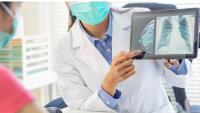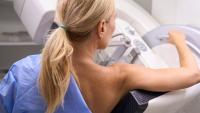Breast Cancer
Make an Appointment
Our team of dedicated access representatives is here to help you make an appointment with the specialists that you need.

Breast cancer involves the growth and multiplication of abnormal cells in breast tissue. This tissue covers your chest (pectoral) muscles. Breast cancer can affect all genders. However, it is the most common type of cancer diagnosed in cisgendered women.
One in eight women in the US will be diagnosed with breast cancer in their lifetimes, and more than 268,600 women are diagnosed each year.
However, deaths from breast have been declining since about 1990. We think this is due to better screening and early detection, as well as scientific discoveries leading to more targeted and tolerated treatments.
More than 2 million people are breast cancer survivors today, and with early detection and treatment many breast cancer patients continue to lead normal lives.
Risk Factors
Some things can increase your chance for breast cancer. Breast cancer risk factors range from genetics (sex, family history) and age to lifestyle (birth control hormone therapy use, body weight, alcohol use).
You may be able to reduce your risk for breast cancer by limiting these risk factors. However, some risk factors are out of your control, like familial, or hereditary risk. If you have a family history of breast cancer, genetic counseling may be right for you.
Risk factors for developing breast cancer include:
Sex
Breast cancer is the most commonly diagnosed cancer in women. However, although rare, it is possible for men to develop breast cancer. Approximately 2,670 cases of male breast cancer are diagnosed each year.
Age
The majority of breast cancers occur in older postmenopausal women. Only about 20% of invasive breast cancers are discovered in women younger than age 50.
Genetic factors and family history
Between 5 and 10% of breast cancers are thought to be hereditary. Mutations in the BRCA1 and BRCA2 genes are the most common cause of hereditary breast cancer. A first-degree relative (mother, sister, or daughter) with breast cancer roughly doubles a woman's risk. However, it is important to note that 80% of all women diagnosed with breast cancer do not have a hereditary form of this disease.
Personal history
A woman with cancer in one breast has almost a sevenfold greater chance of developing a new cancer in the other breast or in another part of the same breast.
Race
White women have a slightly higher chance of developing breast cancer than Black women; but Black women tend to develop more aggressive breast cancers at a younger age. Asian, Hispanic, and Native American women have a lower risk of developing breast cancer compared to non-Hispanic whites.
Dense breast tissue
Women with dense breasts have a higher risk of breast cancer.
Women with benign breast conditions
Women with proliferative lesions including atypia or lobular carcinoma in situ (LCIS) have a higher risk of breast cancer.
More years of menstruating
Women who started menstruating before age 12 and/or started menopause after age 55 have a slightly higher risk of breast cancer.
Not having children
Women who haven’t had children or who gave birth after age 30 have a slightly higher risk for developing breast cancer. Women who’ve had several pregnancies and started their families at a younger age have a reduced risk.
Oral contraceptives
Women who use oral contraceptives (birth control pills) have a slightly higher risk of breast cancer.
Post-menopausal hormone replacement therapy (HRT)
Post-menopausal hormone replacement therapy (HRT) increases breast cancer risk. The use of estrogen and progesterone HRT can elevate risk in as little as two years. It also increases the likelihood that the breast cancer may be found at a more advanced stage.
Alcohol use
One alcoholic drink a day carries a very small increase in breast cancer risk.
Obesity/overweight
Breast cancer risk is greater for women who have gained a significant amount of weight as adults.
Previous chest radiation
Women who, in their childhood or adolescence, received radiation therapy to the chest to treat another cancer have a significantly increased risk for breast cancer.
Diethylstilbestrol (DES) exposure
Women who had taken the drug diethylstilbestrol (DES) have a slightly increased risk of developing breast cancer. Diethylstilbestrol (DES) was prescribed to pregnant women until the 1960s to lessen the chance of miscarriage.
Reducing Your Risk for Breast Cancer
How can you reduce your risk for breast cancer? While most breast cancer is caused by genetic factors, you can do three things that have been shown to reduce breast cancer risk in general:
- Make lifestyle changes to decrease your body weight
- Limit your alcohol intake
- Increase your physical activity
You can also work with a doctor or a genetic counselor to determine if you’re at high risk for developing breast cancer, and if yes, take steps described below as preventive measures.
The most important thing you can do is breast screening. First, regular breast self-exams are key for knowing your own breasts and noticing changes as soon as possible. Then, get annual screening mammograms (if you’re 40 or older, or potentially earlier if you’re at high risk) can help with early detection.
Here are some steps women who are at higher risk for breast cancer can take.
Breast imaging
Digital mammography, breast tomosynthesis, breast ultrasound, and MRI are performed and interpreted by our breast radiology team.
Genetic testing
Our Cancer Genetics Program provides genetic counseling and testing for women with a family history of breast cancer or other breast cancer risk factors.
Risk-reducing surgeries
High-risk women with a genetic predisposition for breast and ovarian cancer may consider risk-reducing surgeries such as mastectomies or removal of both ovaries and fallopian tubes.
Risk-reducing Medications
There are a number of medications approved by the FDA to lower the risk of developing breast cancer among high-risk women.
Lifestyle modification
Certain lifestyle factors can be modified to reduce breast cancer risk. For example, limiting alcohol intake, maintaining a healthy body weight, and increasing physical activity may play a role in reducing breast cancer risk.
Women at Risk
Our affiliated Women at Risk (WAR) program has a distinguished track record in breast cancer research, education, and navigation services. WAR offers a patient resource library and a support group for women at high risk for breast cancer.
Signs of Breast Cancer
While not all of the signs below indicate cancer, if you notice these changes, please talk to your physician:
- Nipple tenderness
- Any nipple discharge
- A lump or thickening in or near the breast or in the underarm area
- A lump in the breast (not all lumps are cancerous but should be evaluated by a physician)
- An unusual change in the size or shape of the breast
- An unusual swelling of the breast (especially if on one side only)
- Shrinkage of the breast (especially if on one side only)
- A new asymmetry of the breasts
- A nipple that has turned slightly inward or become inverted
- Scaly, red or swollen skin on the breast, areola, or nipple
- Ridges, dimpling or pitting in the breast, resembling the skin of an orange
Diagnosing Breast Cancer
Breast imaging technologies allow physicians to detect cancer at an early stage, when patients receive the optimal effects from treatment.
Mammogram
A mammogram is an X-ray image of your compressed breast tissue that can show radiologists changes in your breast tissue. This technology has been an important tool used around the world for early breast cancer diagnosis since 1969.
We recommend mammograms for women over age 40 or 50 every one to two years. We also recommend mammograms for most suspicious breast lumps, often followed by a biopsy to confirm a breast cancer diagnosis.
Ultrasound
If you have dense breast tissue, an ultrasound may help a radiologist better see changes in your breast tissue, especially when paired with a mammogram.
An ultrasound uses sound waves to take images of your breasts. This painless test does not expose you to radiation.
Screening magnetic resonance imaging (MRI)
A screening breast MRI uses strong magnets and radio waves to make images of the inside of your breasts. MRIs usually offer a more detailed picture than mammography or ultrasound.
If you have mutations in the BRCA1/2 genes or other hereditary breast cancer syndromes, previous radiation to the chest, or at least a 20% chance of developing breast cancer in your lifetime, based on risk factors, guidelines recommend that you have regular MRI breast screenings.
In some cases, women with high-risk lesions, atypia, or lobular carcinoma in situ are considered candidates for a screening breast MRI.
Biopsy
During a biopsy, a doctor removes a small sample of tissue or fluid from a lump in your breast.
You can have a needle biopsy in your doctor’s office. After numbing your tissue, your doctor will insert a hollow needle into the lump, then use light suction to remove the sample. The doctor will send the fluid to a lab for analysis. If no abnormal cells are found, you won’t require further tests.
Sometimes, people with breast cancer need a surgical biopsy. During this procedure — often done as outpatient surgery using local or general anesthesia — a surgeon removes the lump and small amounts of surrounding tissue for lab analysis.
About 80% of biopsies show no abnormal cells.
Staging, Metastases, and Recurrence
If you have a cancerous breast tumor, a pathologist will classify it according to its stage of growth. Staging helps your care team determine the most appropriate treatment plan. Breast cancer is classified from early stage (stage 0) to the most advanced stage (stage IV).
- Stage 0 (early stage): Includes findings of DCIS or Paget’s disease, but no invasive cancer.
- Stage I (early stage): Cancer no more than 2 cm across, with no spread to lymph nodes.
- Stage II (early stage): Cancer 2 to 5 cm across, and/or cancer has spread to underarm lymph nodes.
- Stage IIA: Cancer less than 2 cm with lymph node involvement, or cancer between 2 and 5 cm with no lymph node involvement.
- Stage IIB: Cancer larger than 2 cm with lymph node involvement, or cancer larger than 5 cm without lymph node involvement
- Stage III: Also called locally advanced cancer: Cancer larger than 5 cm with cancer in underarm lymph nodes, or that has spread to other lymph node areas or tissues near the breast (such as above or below the clavicle).
- Stage IIIA: Cancer larger than 5 cm with involvement of underarm lymph nodes. Any tumors fitting the description above.
- Stage IIIB: As in IIIA, and associated with chest wall or skin involvement, or inflammatory breast cancer.
- Stage IIIC: Cancer has spread to lymph nodes above the clavicle
- Stage IV: Cancer has spread to another organ in the body (also called metastatic cancer).
Metastases and Recurrence
When breast cancer cells show up in other parts of your body—also known as metastasis—it’s still called breast cancer, even if it’s found in your lungs or your liver. The cells can travel to other organs through the blood vessels and lymph system. You might hear this called metastatic, advanced, or Stage IV breast cancer.
Breast cancer can also come back after treatment, called recurrence. The cancer can appear locally in the skin, in the same breast if it was not removed as part of treatment, or somewhere else in the body. Common areas for recurrent cancer are bones, lungs, brain, liver, and lymph nodes.





